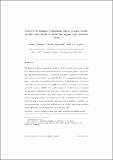Files in this item
A novel 3D atomistic-continuum cancer invasion model : in silico simulations of an in vitro organotypic invasion assay
Item metadata
| dc.contributor.author | Franssen, Linnea C. | |
| dc.contributor.author | Sfakianakis, Nikolaos | |
| dc.contributor.author | Chaplain, Mark Andrew Joseph | |
| dc.date.accessioned | 2022-03-27T00:40:51Z | |
| dc.date.available | 2022-03-27T00:40:51Z | |
| dc.date.issued | 2021-08-07 | |
| dc.identifier | 273263579 | |
| dc.identifier | d0d6a4a6-429c-490a-9e3c-9067d6164132 | |
| dc.identifier | 33781776 | |
| dc.identifier | 85104335410 | |
| dc.identifier | 33781776 | |
| dc.identifier | 000652405200001 | |
| dc.identifier.citation | Franssen , L C , Sfakianakis , N & Chaplain , M A J 2021 , ' A novel 3D atomistic-continuum cancer invasion model : in silico simulations of an in vitro organotypic invasion assay ' , Journal of Theoretical Biology , vol. 522 , 110677 . https://doi.org/10.1016/j.jtbi.2021.110677 | en |
| dc.identifier.issn | 0022-5193 | |
| dc.identifier.other | ORCID: /0000-0001-5727-2160/work/91685807 | |
| dc.identifier.other | ORCID: /0000-0002-2675-6338/work/91685899 | |
| dc.identifier.uri | https://hdl.handle.net/10023/25111 | |
| dc.description | Copyright © 2021 Elsevier Ltd. All rights reserved. | en |
| dc.description.abstract | We develop a three-dimensional genuinely hybrid atomistic-continuum model that describes the invasive growth dynamics of individual cancer cells in tissue. The framework explicitly accounts for phenotypic variation by distinguishing between cancer cells of an epithelial-like and a mesenchymal-like phenotype. It also describes mutations between these cell phenotypes in the form of epithelial-mesenchymal transition (EMT) and its reverse process mesenchymal-epithelial transition (MET). The proposed model consists of a hybrid system of partial and stochastic differential equations that describe the evolution of epithelial-like and mesenchymal-like cancer cells, respectively, under the consideration of matrix-degrading enzyme concentrations and the extracellular matrix density. With the help of inverse parameter estimation and a sensitivity analysis, this three-dimensional model is then calibrated to an in vitro organotypic invasion assay experiment of oral squamous cell carcinoma cells. | |
| dc.format.extent | 14 | |
| dc.format.extent | 756950 | |
| dc.language.iso | eng | |
| dc.relation.ispartof | Journal of Theoretical Biology | en |
| dc.subject | Cancer invasion | en |
| dc.subject | Organotypic assay | en |
| dc.subject | Atomistic-continuum model | en |
| dc.subject | QA Mathematics | en |
| dc.subject | QH301 Biology | en |
| dc.subject | RC0254 Neoplasms. Tumors. Oncology (including Cancer) | en |
| dc.subject | DAS | en |
| dc.subject | SDG 3 - Good Health and Well-being | en |
| dc.subject.lcc | QA | en |
| dc.subject.lcc | QH301 | en |
| dc.subject.lcc | RC0254 | en |
| dc.title | A novel 3D atomistic-continuum cancer invasion model : in silico simulations of an in vitro organotypic invasion assay | en |
| dc.type | Journal article | en |
| dc.contributor.institution | University of St Andrews. Applied Mathematics | en |
| dc.contributor.institution | University of St Andrews. School of Mathematics and Statistics | en |
| dc.identifier.doi | 10.1016/j.jtbi.2021.110677 | |
| dc.description.status | Peer reviewed | en |
| dc.date.embargoedUntil | 2022-03-27 |
This item appears in the following Collection(s)
Items in the St Andrews Research Repository are protected by copyright, with all rights reserved, unless otherwise indicated.

